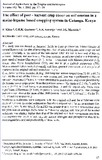The Effect Of Post-harvest Crop Cover On Soil Erosion In A Maize-legume Based Cropping System In Gatanga, Kenya.

View/
Date
2002Author
Khisa, P
Gachene, CKK
Karanja, NK
Mureithi, JG
Type
ArticleLanguage
enMetadata
Show full item recordAbstract
The study was conducted on farmers' fields in Gatanga Division, Thika District of Central Kenya with the aim of assessing the effect of selected legume cover crops on soil erosion especially at the onset of the rain season when the soil is bare and of this on erosion-induced nutrient losses. The four systems tested consisted of the following:
pure stand of maize (Zea mays) (T1), maize intercropped with Mucuna pruriens (T2), maize plus Vicia benghalensis (T3), and maize plus Lablab purpureus (T4). Measurements taken included runoff, soil loss, percent crop cover and analysis of nutrients in the original soil and eroded sediments. Cumulative soil loss recorded during 1999 long rain season ranged from 58.64 to 61.7 t ha^-1. At the onset of the 1999 short rain season, soil loss was significantly different between treatments (P"0.05). This was atributed to post-harvest crop cover provided by the legume cover crops grown from the previous season. The highest (3.3 t ha^-1) and the
lowest (0.35 t ha^-1) soil losses were recorded from T1 and T2 respectively. There were significant differences (P"0.05) in percent cover between treatments. The average percent cover taken at the onset of the 1999 short rain was 0,43.2,9.0 and ll.4%o for Tl, T2, T3 and T4 respectively.
Nutrients in sediments were compared with the original soil and the enrichment ratio (ratio of nutrients in eroded sediment to that ofthe original soil) for major nutrients (i.e. organic C, total N, available P, Ca and K) was greater than 1. The soil material lost from
the plots was on average 262% richer in P than the original soil. The pH of the eroded sediments was slightly higher than that of the original soil. Soil management practices that improve the levels of soil organic matter; nitrogen and phosphorus should be encouraged for sustained productivity of these soils.
URI
http://www.jarts.info/index.php/jats/article/view/1419http://erepository.uonbi.ac.ke:8080/xmlui/handle/123456789/49942
Citation
Journal of Agriculture in the Tropics and Subtropics, Vol 103, pp 17-28Publisher
University of Nairobi Department of Land Resource Management and Agricultural Technology
